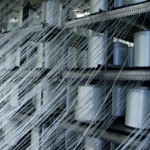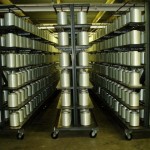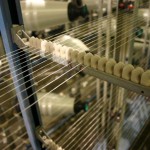
WEAVING:
Below description shall be very simplified and only for the purpose to explain a nonexpert the general process of weaving. We hope this helps with the basic understanding of weaving and as such with a particular project in question. Of course, there is a lot more to it, but that will be our job!
In very simple terms, during the weaving process one thread (also called the “fill”) will travel from the left side to the right side of the weaving machine. While doing so, minimum one harness is holding up many threads coming from a perpendicular direction (called “warp threads”) and another harness from the same perpendicular direction will keep many warp threads down. This creates an opening (also called the “shed”) through which the fill thread travels.
Once the fill thread makes it all the way through the shed, it will be cut on the left side of the machine and the two harnesses will move in the opposite direction (the one which was up will go down and the one which was down will go up). This will lock in the fill and creates a new opening for the process to be repeated.
One such process is also called a pick and after one pick is taken place, the machine moves the fabric forward to create space for the following pick.
The below slow motion video shows how a pick takes place. During this weaving technique, a gripper takes the fill from the left side and and transports it to the center. From the center, the right side gripper is then taking over the fill and transports it to the right side.
A reed, through which the warp threads are conducted, is pushing the fill thread towards the cloth side and makes sure it is in alinement with the fabric. The process is called the beat and it takes place, after the fill thread has been fully inserted and the two grippers moved completely out of the shed.
WEAVING FROM A CREEL
Below pictures indicate weaving from a creel.
Typically, heavier threads or high density fibers (warp fibers/ yarns/ threads) will be woven from a creel. You can see the many bobbins are stacked on a shelf system and then threaded into the machine.



WEAVING FROM A LOOM BEAM
Below pictures shows the preparation of a loom beam. In this case, a sectional warping device winds a few hundred threads on a large beam. This creates one section. The process will be repeated with many of such sections with the exact same length and the exact same fiber count of each section.
After that process, all sections will be wound onto a loom beam in one production step. The loom beam then can be mounted to the weaving machine.
Explanation of the pictures: From the left, the first picture represents the sectional warping machine. The second picture a yarn guide, the third picture is a bobbin with glass fiber, the fourth picture shows a weaving machine which holds a loom beam with all the sections wound to it.




Below video shows how a basalt woven mesh is wound up on an “off-loom-take-up”.
We hope these simple explanations and examples help to understand when discussing projects relevant to contract weaving.